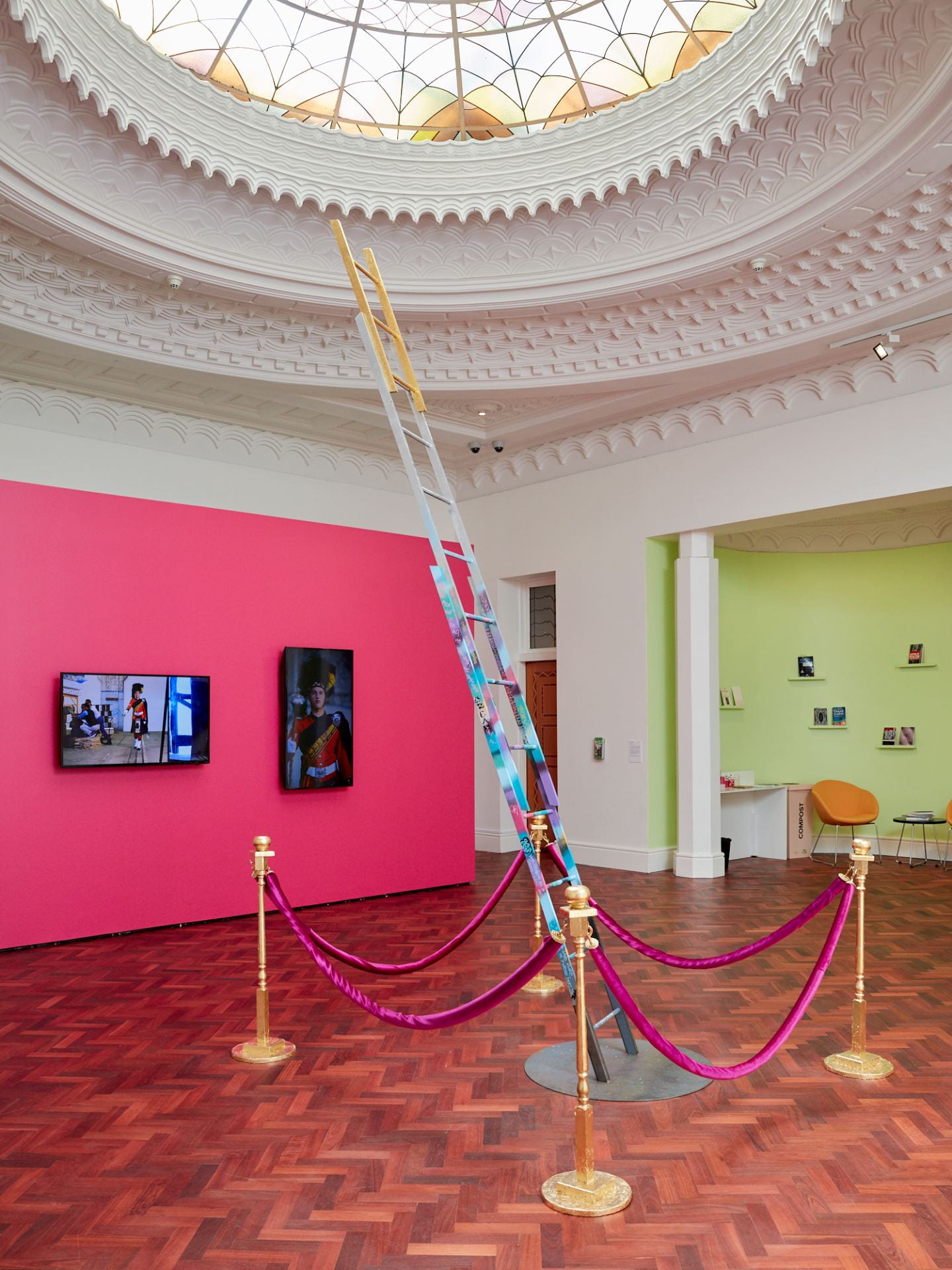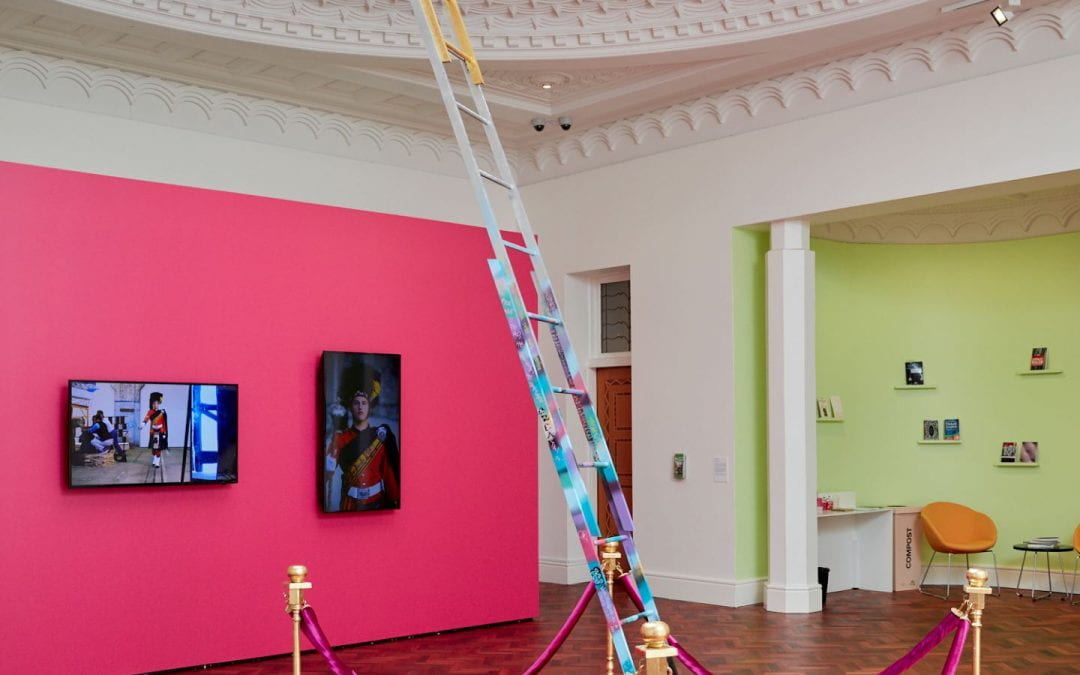Aroha Novak is an artist based in Ōtepoti Dunedin. Her large installation The right to be unequal was commissioned for our exhibition We’re Not Too Big to Care, 2019.
Can you tell us a little bit about your work that has been in Gus Fisher Gallery’s exhibition programme?
The work I made was a sculptural installation for the We’re Not Too Big to Care exhibition in April 2019. It was a visual ‘scale of economies’ titled The right to be unequal – a 3.6 m high ladder reaching up towards the dome glass ceiling situated in the foyer of the Gus Fisher Gallery, and cordoned off with velvet ropes and gold bollards. The right to be unequal was created specifically for the gallery site, fitting the architecture perfectly, as well as geographically being nestled in the heart of Auckland’s financial district.
The title of the work references a speech by Margaret Thatcher made in the 1980s that justified major economic reforms – the start of neoliberalism and the privatisation of traditionally government-funded resources and entities that other nations like New Zealand adopted shortly thereafter. Surrounding the outside of this work are four bollards made from reused wood and gilded in fake gold leaf with velvet ropes cordoning off the ladder from the public. The materials of the ladder are light pine wood with a metal base coated in paint, spray paint, posca pens and 24 carat gold leaf – the ‘visual scale’ references the economic ‘trickle down’ theory with the very top tip of the ladder coated in 24 carat gold, silver and beautiful vibrant colours following until it gets more rough and minimal ending in a metal base structure. Tagged along the rungs and sides are quotes from various New Zealand Prime Ministers about neoliberalism, Rogernomics and inequality in New Zealand. This work highlights the fact that since the 1980s, New Zealand has moved further into a neoliberal system of economics which in turn has widened the inequality gap between the ‘haves’ and the ‘have nots’.

Aroha Novak, The right to be unequal, 2019. Photograph by Sam Hartnett.
It is interesting to see how the current global pandemic has highlighted the inequities found within New Zealand society. For example, hundreds of homeless people are now being put into Motel accommodation in order to help keep the national expectation of safe social distancing. This crisis has repositioned priorities for the government, and for the public, forcing decisions as to what is essential to keep a society going, creating access to educational tools, devices and internet for all demographics, and helping the most vulnerable in society.
What have you been working on since then?
I was five months pregnant at the time of install last year, so since the exhibition my partner and I sold our house, bought a bigger one, and then had a baby in quick succession! We have three children altogether and needed an extra room as they are all very different ages (12, 7 and 7 months). I have a part-time job at the public library (which helps to pay the bills consistently) and I have been on maternity leave from that since July. I have a mural commission which I was meant to paint the week NZ went into lockdown, so that will happen when it is safe to do so – hopefully soon!
Luckily our new house has a large garage which I am slowly converting into studio space. So during lockdown, I have been working on a baby, a studio space, a garden, and domestic family life. I have been taking a visual account of our lockdown life by drawing a picture every day and posting these onto my Instagram account.
What are you doing to entertain/occupy yourself in self-isolation?
I have three kids (one is a baby), a dog, a partner, and my brother and his girlfriend (who are staying with us) all in my bubble, so all of these people keep me rather busy at the moment. And, to be honest, having a newborn baby is like going into isolation so I feel like I have been in training for this anyway! I have also been keeping myself occupied by trying to get some unfinished jobs finished: we have been putting a library together in our hallway so I have been painting the walls and unpacking books; we have a lot of garden to maintain and have been digging away at that; I have been insulating and sorting out a studio space for myself in the garage (there is a lot of work to do there!); and we have been baking a lot and making elaborate meals. Also walking every day – we are lucky to be near the harbour and can walk along there or up the hill. I have been watching all the Studio Ghibli movies with my kids, as well as playing Just Dance and drawing/painting every day. We also have an ‘Isolation diary’ where we have all tried to write down various notes and I draw a picture and have been posting these daily onto Instagram. We have just started home school which is a learning experience all round – definitely hard work and has given us all a new found appreciation for the kids’ teachers.

Portrait of Aroha Novak and pēpi.
What are you reading right now?
I have just finished Killing Commendatore by Haruki Murakami, a novel about an artist in Japan who paints portraits for a living but really wants to be doing different painting work (a case of working for money…). He finds himself divorced from his wife and living (basically in isolation) on a mountain in a house that was once belonged to a famous artist. He encounters some supernatural happenings by uncovering a pit behind a shrine in the woods. I am also reading (very slowly) The Struggle Without End by Ranginui Walker – a really thorough exploration into Te Ao Maori in New Zealand, going through different subjects (such as tapu, whenua, etc.) and explaining them in detail. It is also a prescient account of a Māori history from a Māori perspective – definitely should be a must read for every New Zealander! I am also reading Still Life by Louise Penny – a murder mystery set in Quebec territory.

Aroha Novak, The right to be unequal (detail), 2019. Photograph by Sam Hartnett.
Can you describe the home you are currently self-isolating in to us?
Our house is a 3/4 bedroom, one-level 1940s bungalow, with a standard hallway in the middle with rooms coming off that. It is a creamy beige colour with a red front door and has a front garden with bright pink and orange dahlias, a bunch of other flowers that were here, and then fruiting plants I have introduced. When we shifted we knocked out a few walls to make the living area open into the kitchen and not so pokey, as well as the hallway area into a library nook. Our kids have a bedroom each and our bedroom has another room off it which is being used for storage at the moment. There is a driveway that leads to the piece de la resistance: the garage and my happy place. It is a double garage with an insulated loft space where my brother and his girlfriend are staying. The garage has old, north-facing windows and plenty of space/potential for studio space. The back yard is a large, rectangle flat section with lots of firewood storage, a veggie patch and a glasshouse. There are no large trees in our back yard so we have started planting different fruit trees – apple, plum, apricot and tamarillo – with plans to grow more. It is a very spacious house (especially in comparison to our last home which was a two bedroom cottage) with lots of projects on the go, so we are very lucky to be self-isolating in this space.
